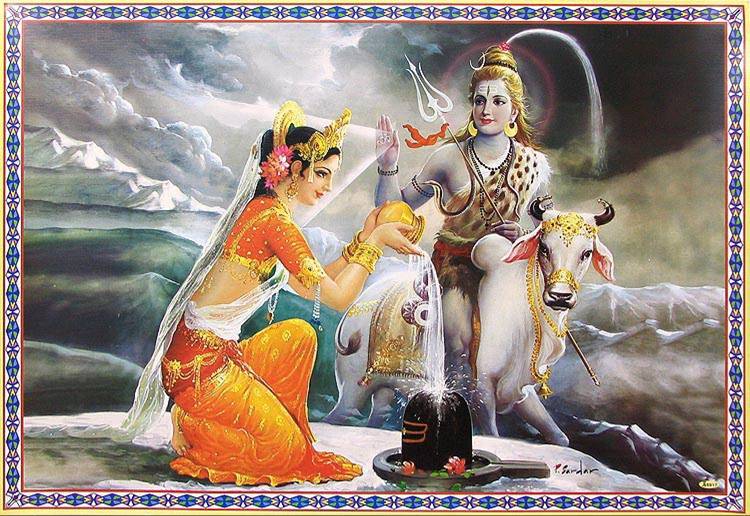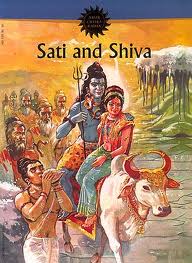Stories of Lord Shiva, forms and explanations
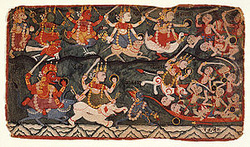
The 18 purANas ( are have very rich accounts of ancient happenings.
16 Monday Fasting
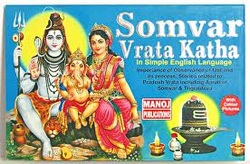
Vow of Worship of Lord Shiva for Sixteen Mondays ~~OM~~
This is the story of the worship to be performed on sixteen consecutive Mondays.
One day Bhagawan Bhutanath, Lord Shiva, as the Lord of all Beings, went to tour the sansar (the world of objects and relationships) along with his beloved wife Parvati. They were traveling, seeing many different lands, when they came to the city of Amaravati. There they saw a great shining city, and they took shelter in one particular Shivaloya, a temple of Lord Shiva.
One day Parvati had a desire to play "chalsar", an Indian dice game. While Shiva and Parvati sat enjoying this game, a Brahmin pujari walked into the temple. Parvati stopped and asked the priest, "Who will win this game?"
Without hesitation or much thought the pujari immediately responded, "Shankarji. Shiva will win."
After a short time Parvati did in fact lose the dice game and she became very angry. She thought that it was because of the Brahmin's prediction that she had lost the game. Shiva advised Parvati to remain calm and to control her anger, but Parvati would not be easily appeased. Her anger grew into a great rage and she cursed the Brahmin who had said she would lose the game. Parvati cursed the Brahmin that he would suffer from leprosy.
The Brahmin priest was immediately attacked by the disease, and he became very sad and was filled with great pain from the leprosy that developed. Many days passed and the priest suffered a great deal. He thought, "For what karma have I received such a curse from the Divine Mother? What will I ever be able to do to get her grace once again?" In this way his mind was extremely agitated, and his body pained.
One day that Brahmin priest went into the Shiva temple, where he saw a most beautiful heavenly nymph. This beautiful and shining angelic lady was an Apsara, a celestial maiden who serves the Gods. Standing before the pain stricken priest, she gave him the following instructions: "With all of your energy and devotion to the greatest extent of your capacity, perform the vow of Shiva's worship on sixteen consecutive Mondays. All of the pain and suffering that now afflict you will completely dissolve if you worship Lord Shiva with pure devotion."
The radiant Apsara then proceeded to tell the poor afflicted Brahmin exactly how to perform the puja. "In the early morning of each Monday you will bathe and wear a pure white cloth on your body. At the time of cooking you will take a pound of pure white wheat flour, mix with gur and ghee and fry. Offer this 'Churma' along with a ghee lamp, as well as gur, beetle nut, a sacred thread, sandal paste, some grains of rice and flowers. With these items especially, you will worship Lord Shiva. You will adorn the blessed Lord Shiva with three lines horizontally and with one mark in the center, and after this you may also take prasad just as you have offered to Shiva. Recite his mantras, sing His songs, perform the fire sacrifice, and other forms of worship for the Lord.
"Completing your worship to Lord Shiva in this way for sixteen Mondays, on the seventeenth Monday you will take ten pounds of pure wheat flour, mix with ghee and gur and fry. Offer this 'Churma' to the great Lord Shiva with all of your devotion and love. You may then partake of the prasad, sharing in the blessings of Lord Shiva. If you observe all that I have instructed, you will certainly be freed from all pain and suffering, and you will soon attain the highest graces and good fortune."
Finishing her discourse, the Apsara rose up and ascended into the heavens. The Brahmin was completely amazed by this vision, and with full faith, he observed the sankalpa of sixteen Mondays in every detail. Every Monday he wore a pure white cloth, and chanted the worship of Lord Shiva, offering the appropriate offerings. Following this vow, he was freed from his disease and sorrow. He became a well known, wealthy man and loved and respected by all of the people of the kingdom. He taught the worship of Lord Shiva to many people, and continued to inspire the people of his community to serve the Lord with truth and joy.
One day that Brahmin priest returned to the temple where Parvati had first cursed him. Parvati was amazed to se that the Brahmin was healed of his disease. When Parvati learned of the power of the vow of sixteen Mondays, she quickly went to her son Kartikeya to share with him this wonderful secret of the regular worship of Lord Shiva.
Kartikeya shared the secret of this worship with his friend. This friend had no wife and desiring to marry, he at once make the sankalpa, or spiritual promise, to observe the vow of sixteen weeks, praying for the blessing of a good marriage. After completing his vow of worship for sixteen Mondays, the man left his native land and traveled to another Kingdom. Arriving at this new land, he heard that the King had made a very strange public declaration. That King had promised his daughter's hand in marriage to the one who be chosen by his elephant. The King's elephant would place a garland of flowers around some man's neck, according to divine understanding, and that man would become the husband of the princess.
The traveler went to witness this betrothal ceremony, as he had never heard of such a curious way of fixing a marriage. The elephant looked at all the men assembled for the occasion, and then put the garland around his neck. The king happily gave his daughter in marriage, and the traveler became a member of the Royal household.
It was some years later, that the King's daughter found out that her husband had been chosen for the marriage after he had performed the vow of Lord Shiva's worship for sixteen Mondays for that purpose. She was eager to have a son, and decided to perform the vow of Lord Shiva's worship for sixteen Mondays in order to have a beautiful son who could become a king. The wife did this vow with such devotion and love that Shiva was pleased, and she gave birth to a wonderful son.
When the child grew up, he desired to become the king of a nation, and therefore, he also took the vow of Lord Shiva's worship for sixteen Mondays to become a good king. When his vow was complete, a messenger came from another King asking whether he might like to join with his daughter to become his wife. He was very happy when he heard of this proposal, and he immediately consented, and the King performed the marriage in a gay fashion. The King was delighted to have completed his responsibility to his daughter, and being an old man, he left his body just a short time following the marriage. The young man then inherited the throne.
Immediately after taking over the duties of the kingdom, the new King asked his wife to gather together all of the ingredients for Shiva's puja. But his wife passed this order to one of her servants, who prepared everything for the worship. While doing the puja, the King received a message which was as follows: " If the King would not leave that insolent wife, then his lineage would be finished."
Upon hearing this message, the King was extremely pained and filled with wonder. He asked the ministers what was the matter, and what should he do? The ministers advised him to leave the wife or he would face ruin. Because the wife had not obeyed the King's order to get ready his puja, but instead had asked her servant to do this, such a wife would only cause him problems. The King again asked the ministers what he should do, and they quickly told him, "Leave the Queen!"
The queen was very sorry when she was exiled from the palace. She wandered on her way, but no one would give her shelter. By this time her status was reduced to a beggar. Her cloth was torn and she had no shoes.
She tried to seek refuge with an old man, but she was chased away. Then she asked for help from an old servant who was washing dishes, but she was scared away. The queen had no place and was cold and frightened. A milk man took her to a nearby Shiva temple, where she told the priest her whole story. He had deep compassion for the poor woman, and he gave her refuge in his temple. But whatever the queen touched became ruined. Worms came into all of the food that she touched, and at this the priest was extremely pained.
Then he told the queen to appease Lord Shiva by observing the vow of sixteen Mondays. He explained to her the entire process, and with great faith and devotion the queen followed this advice of the priest.
On the seventeenth Monday, the King heard a divine voice telling him to search for his wife. Then he sent ambassadors to search everywhere for the exiled queen, and finally they came to the temple where she was residing. Learning the whereabouts of his beloved wife, the king immediately went to that temple to find her.
When the King learned how the queen had performed the vow of Shiva's worship for sixteen consecutive Mondays, then he was very happy, and he went to the temple priest to do him service and honor in thanks. The priest listened to the King's story, and blessed them both.
When the King and Queen returned to the capital all of the subjects of the kingdom welcomed them both with great love and devotion. Then the king gave the people many gifts, and always worked hard at their service. With the grace of Lord Shiva the King and Queen had beautiful children, enjoyed many years of comfort and happiness in their Kingdom, and ultimately went to the Shivaloka.
This is the story of the vow of Lord Shiva's Worship. Whoever will read it with devotion, or listen to it with one pointed attention, at the time of worship on Monday, will be blessed with health, wealth, the cessation of all disturbances, and the fulfillment of all desires. This is the promise of Lord Shiva. OM NAMAH SHIVAAYA.
This is the story of the worship to be performed on sixteen consecutive Mondays.
One day Bhagawan Bhutanath, Lord Shiva, as the Lord of all Beings, went to tour the sansar (the world of objects and relationships) along with his beloved wife Parvati. They were traveling, seeing many different lands, when they came to the city of Amaravati. There they saw a great shining city, and they took shelter in one particular Shivaloya, a temple of Lord Shiva.
One day Parvati had a desire to play "chalsar", an Indian dice game. While Shiva and Parvati sat enjoying this game, a Brahmin pujari walked into the temple. Parvati stopped and asked the priest, "Who will win this game?"
Without hesitation or much thought the pujari immediately responded, "Shankarji. Shiva will win."
After a short time Parvati did in fact lose the dice game and she became very angry. She thought that it was because of the Brahmin's prediction that she had lost the game. Shiva advised Parvati to remain calm and to control her anger, but Parvati would not be easily appeased. Her anger grew into a great rage and she cursed the Brahmin who had said she would lose the game. Parvati cursed the Brahmin that he would suffer from leprosy.
The Brahmin priest was immediately attacked by the disease, and he became very sad and was filled with great pain from the leprosy that developed. Many days passed and the priest suffered a great deal. He thought, "For what karma have I received such a curse from the Divine Mother? What will I ever be able to do to get her grace once again?" In this way his mind was extremely agitated, and his body pained.
One day that Brahmin priest went into the Shiva temple, where he saw a most beautiful heavenly nymph. This beautiful and shining angelic lady was an Apsara, a celestial maiden who serves the Gods. Standing before the pain stricken priest, she gave him the following instructions: "With all of your energy and devotion to the greatest extent of your capacity, perform the vow of Shiva's worship on sixteen consecutive Mondays. All of the pain and suffering that now afflict you will completely dissolve if you worship Lord Shiva with pure devotion."
The radiant Apsara then proceeded to tell the poor afflicted Brahmin exactly how to perform the puja. "In the early morning of each Monday you will bathe and wear a pure white cloth on your body. At the time of cooking you will take a pound of pure white wheat flour, mix with gur and ghee and fry. Offer this 'Churma' along with a ghee lamp, as well as gur, beetle nut, a sacred thread, sandal paste, some grains of rice and flowers. With these items especially, you will worship Lord Shiva. You will adorn the blessed Lord Shiva with three lines horizontally and with one mark in the center, and after this you may also take prasad just as you have offered to Shiva. Recite his mantras, sing His songs, perform the fire sacrifice, and other forms of worship for the Lord.
"Completing your worship to Lord Shiva in this way for sixteen Mondays, on the seventeenth Monday you will take ten pounds of pure wheat flour, mix with ghee and gur and fry. Offer this 'Churma' to the great Lord Shiva with all of your devotion and love. You may then partake of the prasad, sharing in the blessings of Lord Shiva. If you observe all that I have instructed, you will certainly be freed from all pain and suffering, and you will soon attain the highest graces and good fortune."
Finishing her discourse, the Apsara rose up and ascended into the heavens. The Brahmin was completely amazed by this vision, and with full faith, he observed the sankalpa of sixteen Mondays in every detail. Every Monday he wore a pure white cloth, and chanted the worship of Lord Shiva, offering the appropriate offerings. Following this vow, he was freed from his disease and sorrow. He became a well known, wealthy man and loved and respected by all of the people of the kingdom. He taught the worship of Lord Shiva to many people, and continued to inspire the people of his community to serve the Lord with truth and joy.
One day that Brahmin priest returned to the temple where Parvati had first cursed him. Parvati was amazed to se that the Brahmin was healed of his disease. When Parvati learned of the power of the vow of sixteen Mondays, she quickly went to her son Kartikeya to share with him this wonderful secret of the regular worship of Lord Shiva.
Kartikeya shared the secret of this worship with his friend. This friend had no wife and desiring to marry, he at once make the sankalpa, or spiritual promise, to observe the vow of sixteen weeks, praying for the blessing of a good marriage. After completing his vow of worship for sixteen Mondays, the man left his native land and traveled to another Kingdom. Arriving at this new land, he heard that the King had made a very strange public declaration. That King had promised his daughter's hand in marriage to the one who be chosen by his elephant. The King's elephant would place a garland of flowers around some man's neck, according to divine understanding, and that man would become the husband of the princess.
The traveler went to witness this betrothal ceremony, as he had never heard of such a curious way of fixing a marriage. The elephant looked at all the men assembled for the occasion, and then put the garland around his neck. The king happily gave his daughter in marriage, and the traveler became a member of the Royal household.
It was some years later, that the King's daughter found out that her husband had been chosen for the marriage after he had performed the vow of Lord Shiva's worship for sixteen Mondays for that purpose. She was eager to have a son, and decided to perform the vow of Lord Shiva's worship for sixteen Mondays in order to have a beautiful son who could become a king. The wife did this vow with such devotion and love that Shiva was pleased, and she gave birth to a wonderful son.
When the child grew up, he desired to become the king of a nation, and therefore, he also took the vow of Lord Shiva's worship for sixteen Mondays to become a good king. When his vow was complete, a messenger came from another King asking whether he might like to join with his daughter to become his wife. He was very happy when he heard of this proposal, and he immediately consented, and the King performed the marriage in a gay fashion. The King was delighted to have completed his responsibility to his daughter, and being an old man, he left his body just a short time following the marriage. The young man then inherited the throne.
Immediately after taking over the duties of the kingdom, the new King asked his wife to gather together all of the ingredients for Shiva's puja. But his wife passed this order to one of her servants, who prepared everything for the worship. While doing the puja, the King received a message which was as follows: " If the King would not leave that insolent wife, then his lineage would be finished."
Upon hearing this message, the King was extremely pained and filled with wonder. He asked the ministers what was the matter, and what should he do? The ministers advised him to leave the wife or he would face ruin. Because the wife had not obeyed the King's order to get ready his puja, but instead had asked her servant to do this, such a wife would only cause him problems. The King again asked the ministers what he should do, and they quickly told him, "Leave the Queen!"
The queen was very sorry when she was exiled from the palace. She wandered on her way, but no one would give her shelter. By this time her status was reduced to a beggar. Her cloth was torn and she had no shoes.
She tried to seek refuge with an old man, but she was chased away. Then she asked for help from an old servant who was washing dishes, but she was scared away. The queen had no place and was cold and frightened. A milk man took her to a nearby Shiva temple, where she told the priest her whole story. He had deep compassion for the poor woman, and he gave her refuge in his temple. But whatever the queen touched became ruined. Worms came into all of the food that she touched, and at this the priest was extremely pained.
Then he told the queen to appease Lord Shiva by observing the vow of sixteen Mondays. He explained to her the entire process, and with great faith and devotion the queen followed this advice of the priest.
On the seventeenth Monday, the King heard a divine voice telling him to search for his wife. Then he sent ambassadors to search everywhere for the exiled queen, and finally they came to the temple where she was residing. Learning the whereabouts of his beloved wife, the king immediately went to that temple to find her.
When the King learned how the queen had performed the vow of Shiva's worship for sixteen consecutive Mondays, then he was very happy, and he went to the temple priest to do him service and honor in thanks. The priest listened to the King's story, and blessed them both.
When the King and Queen returned to the capital all of the subjects of the kingdom welcomed them both with great love and devotion. Then the king gave the people many gifts, and always worked hard at their service. With the grace of Lord Shiva the King and Queen had beautiful children, enjoyed many years of comfort and happiness in their Kingdom, and ultimately went to the Shivaloka.
This is the story of the vow of Lord Shiva's Worship. Whoever will read it with devotion, or listen to it with one pointed attention, at the time of worship on Monday, will be blessed with health, wealth, the cessation of all disturbances, and the fulfillment of all desires. This is the promise of Lord Shiva. OM NAMAH SHIVAAYA.
Why do we worship the Shiva Linga? LINGODBHAVAR
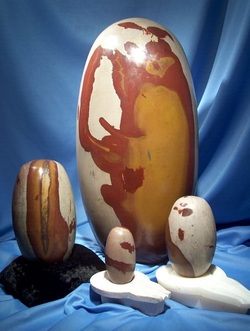
liNgodbhavar
shlokam: Divine, Out of the symbol (li~Ngam) that arose out of the quarrel of prime-ness (between braHma and viShNu), Matted hair crested, Keeping the hand on the hip, with the other hands holding deer and protection sign, in the right holding axe, having the braHma and viShnu (who sought) the Transcending feet and crown, as the swan above and boar below, that li~Ngodbhava I meditate.
purANa of the deity li~Ngodbhavar: The Lord appearing from the symbol. (The principle behind linga worship)
Once before the creation started, a quarrel broke between braHma and viShNu as to who is great. braHma claimed he is as he is the creator of the whole world. viShNu rejected the claim saying the creation would not be useful without his sustenance of the world. The war of words between these two great divines worsened. At that point of time to make them realize the truth there appeared a pillar of fire. It was huge that both of them were astonished to see that. Now as a solution to their debate they wanted to decide who is the greatest by reaching the tip of that pillar. braHma took the form of a haMsa (swan) and went up to reach the top of that pillar, viShNu took the form of a wild pig and went down to reach the bottom of that pillar and it was agreed that whoever sees the either tip would be the greatest.
That pillar was not any ordinary column of fire, it was the Supreme Itself, the One that is beyond form, color and qualities ! Who knows the start and end of that Supreme !! The two who set out on their strength to explore the endings of It went on and on only to become more and more tired and it was hopeless to find the end of It. viShNu returned realizing that it should be the parashiva which is beyond the limits that can be measured by knowledge, Which has come out of Its Grace to bless them and make them realize the Truth easily. He accepted his failure. braHmA on the other hand, though realizing it is impossible to see the top of the fire column, returned lying that he saw the tip. The lie stood exposed and hence he is not worshipped. Now both of them realizing the greatness of the Supreme worshipped the Lord shiva, the Gracious one, with lots of devotion and sincerity. The Lord out of the grace to bless all the pashus (souls) with a way they could easily understand and worship the Supreme, Which is unexplainable, unexplorable, appeared as a li~Ngam which is a vertical pillar resembling the flame. As it resembles the flame, It is neither a form nor a formless, but is just a symbol of the Supreme jyoti. The Lord later appeared in a form and blessed viShNu and braHma. This Lord is called li~Ngodbhavar.
This form which came out of the formless Supreme out of Its grace to bless the sincere worship of braHma and viShNu and which is a from but represents the formlessness of the Supreme is considered very holy by the shaivites. The shiva li~Nga (meaning symbol of shiva) is the foremost of all the shaivite worships. As the ash would be closely associated with the fire, Holy Ash is associated with this Fire pillar Lord and sacred for the shaivites.
shlokam: Divine, Out of the symbol (li~Ngam) that arose out of the quarrel of prime-ness (between braHma and viShNu), Matted hair crested, Keeping the hand on the hip, with the other hands holding deer and protection sign, in the right holding axe, having the braHma and viShnu (who sought) the Transcending feet and crown, as the swan above and boar below, that li~Ngodbhava I meditate.
purANa of the deity li~Ngodbhavar: The Lord appearing from the symbol. (The principle behind linga worship)
Once before the creation started, a quarrel broke between braHma and viShNu as to who is great. braHma claimed he is as he is the creator of the whole world. viShNu rejected the claim saying the creation would not be useful without his sustenance of the world. The war of words between these two great divines worsened. At that point of time to make them realize the truth there appeared a pillar of fire. It was huge that both of them were astonished to see that. Now as a solution to their debate they wanted to decide who is the greatest by reaching the tip of that pillar. braHma took the form of a haMsa (swan) and went up to reach the top of that pillar, viShNu took the form of a wild pig and went down to reach the bottom of that pillar and it was agreed that whoever sees the either tip would be the greatest.
That pillar was not any ordinary column of fire, it was the Supreme Itself, the One that is beyond form, color and qualities ! Who knows the start and end of that Supreme !! The two who set out on their strength to explore the endings of It went on and on only to become more and more tired and it was hopeless to find the end of It. viShNu returned realizing that it should be the parashiva which is beyond the limits that can be measured by knowledge, Which has come out of Its Grace to bless them and make them realize the Truth easily. He accepted his failure. braHmA on the other hand, though realizing it is impossible to see the top of the fire column, returned lying that he saw the tip. The lie stood exposed and hence he is not worshipped. Now both of them realizing the greatness of the Supreme worshipped the Lord shiva, the Gracious one, with lots of devotion and sincerity. The Lord out of the grace to bless all the pashus (souls) with a way they could easily understand and worship the Supreme, Which is unexplainable, unexplorable, appeared as a li~Ngam which is a vertical pillar resembling the flame. As it resembles the flame, It is neither a form nor a formless, but is just a symbol of the Supreme jyoti. The Lord later appeared in a form and blessed viShNu and braHma. This Lord is called li~Ngodbhavar.
This form which came out of the formless Supreme out of Its grace to bless the sincere worship of braHma and viShNu and which is a from but represents the formlessness of the Supreme is considered very holy by the shaivites. The shiva li~Nga (meaning symbol of shiva) is the foremost of all the shaivite worships. As the ash would be closely associated with the fire, Holy Ash is associated with this Fire pillar Lord and sacred for the shaivites.
Why Blue Throat? Neelkantha
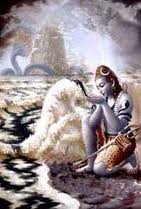
Shlokam: With protection and boon giving posture of hands, with axe and deer, wearing moon, snakes, yellow robe, Three eyed, Auspicious, Dark-blue throated, that Divine riding the bull, Remover of the poison, Colorful (peacock) feather like formed (I salute).
purANa of the deity nIla kaNThar: black (blue) throated Lord
Demons and gods wanted to have the amR^ita the nectar that would make one live long avoiding death. The amR^ita was in the milky ocean and required churning the huge ocean to get out the nectar. They came together to collectively churn the big ocean. They churned the milk ocean with ma.ndhAra mountain as the stem and serpent vAsuki as the rope. In the process, due to the pain serpent vAsuki emitted the poison hAla (meaning destructive). At the same time one more poison came from the ocean hAla. Both put together became an disastrous poison that threatened the very existence of all including the divines, deamons and the other lives. mahA vishNu tried to stop that. His body turned blue, but he couldn't stop it. Terrified by the destroying power of the poison, all of them surrendered to Lord Shiva, the Giver of Refuge. (So far they had never thought of Lord shiva to offer first the amR^ita, but only when it came to disaster they remembered God !)
The Graceful God took the hAlAhalam as if it is a fruit in the hand. Asked all of them, what He should do with that. They pleaded that the poison would annihilate them all if He left it off. Lord smilingly put it into His mouth ! But isn't all the worlds very much inside the God ? Though it will not affect the Lord, but the worlds would be again affected by the poison, Goddess Shakthi, the mother of all creatures, stopped the poison in His throat by putting her hand in His throat. The poison stayed there as a small black (blue) stain. Hence the Lord is called nIlakaNThar .
Now with the blessings of God, the divines continued to churn the ocean and got the amR^ita. God gave the amR^ita to the divines, but had only the poison. For the Lord, Who remains Eternal even after the divines who ate the amR^ita die, what is the need for amR^ita ? He is the greatest amR^ita one can seek!
See Also:
1. pradOsham
purANa of the deity nIla kaNThar: black (blue) throated Lord
Demons and gods wanted to have the amR^ita the nectar that would make one live long avoiding death. The amR^ita was in the milky ocean and required churning the huge ocean to get out the nectar. They came together to collectively churn the big ocean. They churned the milk ocean with ma.ndhAra mountain as the stem and serpent vAsuki as the rope. In the process, due to the pain serpent vAsuki emitted the poison hAla (meaning destructive). At the same time one more poison came from the ocean hAla. Both put together became an disastrous poison that threatened the very existence of all including the divines, deamons and the other lives. mahA vishNu tried to stop that. His body turned blue, but he couldn't stop it. Terrified by the destroying power of the poison, all of them surrendered to Lord Shiva, the Giver of Refuge. (So far they had never thought of Lord shiva to offer first the amR^ita, but only when it came to disaster they remembered God !)
The Graceful God took the hAlAhalam as if it is a fruit in the hand. Asked all of them, what He should do with that. They pleaded that the poison would annihilate them all if He left it off. Lord smilingly put it into His mouth ! But isn't all the worlds very much inside the God ? Though it will not affect the Lord, but the worlds would be again affected by the poison, Goddess Shakthi, the mother of all creatures, stopped the poison in His throat by putting her hand in His throat. The poison stayed there as a small black (blue) stain. Hence the Lord is called nIlakaNThar .
Now with the blessings of God, the divines continued to churn the ocean and got the amR^ita. God gave the amR^ita to the divines, but had only the poison. For the Lord, Who remains Eternal even after the divines who ate the amR^ita die, what is the need for amR^ita ? He is the greatest amR^ita one can seek!
See Also:
1. pradOsham
Why the crescent moon?
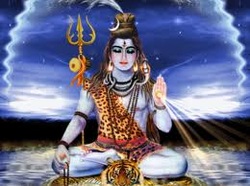
With the hands in abhaya (protecting) and varada (boon giving) postures, with a pleasing and decorated expression, a blossomed face and eye, with the shadow created by moon on the crown, with an upright body, and feet in the same level, Coral like formed, holding the deer and axe, (He) stay in the lotus pedestal. (of my heart)
purANa of the deity : cha.ndra shEkharar : moon ornamented Lord (bhOga mUrti)
daksha had twenty seven stars as daughters. All of them were married to moon. But the moon had special attraction towards rOhiNi. So all the other wives complained it to the father dakasha that their husband moon is not treating them fairly. daksha got angry and cursed the moon to lose its luminance (kala) day by day. Everyday the moon started loosing one luminance part (kala) out of his 16 parts. Afraid and ashamed moon disappeared into the ocean. There are many herbs that require the light of the moon to grow. Without moon, they were harmed. Consequently there was suffering in the world. To end the problem the celestials advised moon to take refuge in the Great Divine, Lord shiva. Left with only one kalA, he took refuge in Lord Shiva. Being the graceful Almighty, He wore the moon crescent on His head, making him grow for 15 days and decay for 15 days periodically.
Thus chan^drashEkharar is considered a giver of refuge.
16 Monday Fast // Vow of Worship of Lord Shiva for Sixteen Mondays
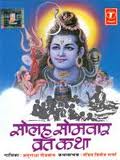
~~OM~~
This is the story of the worship to be performed on sixteen consecutive Mondays.
One day Bhagawan Bhutanath, Lord Shiva, as the Lord of all Beings, went to tour the sansar (the world of objects and relationships) along with his beloved wife Parvati. They were traveling, seeing many different lands, when they came to the city of Amaravati. There they saw a great shining city, and they took shelter in one particular Shivaloya, a temple of Lord Shiva.
One day Parvati had a desire to play "chalsar", an Indian dice game. While Shiva and Parvati sat enjoying this game, a Brahmin pujari walked into the temple. Parvati stopped and asked the priest, "Who will win this game?"
Without hesitation or much thought the pujari immediately responded, "Shankarji. Shiva will win."
After a short time Parvati did in fact lose the dice game and she became very angry. She thought that it was because of the Brahmin's prediction that she had lost the game. Shiva advised Parvati to remain calm and to control her anger, but Parvati would not be easily appeased. Her anger grew into a great rage and she cursed the Brahmin who had said she would lose the game. Parvati cursed the Brahmin that he would suffer from leprosy.
The Brahmin priest was immediately attacked by the disease, and he became very sad and was filled with great pain from the leprosy that developed. Many days passed and the priest suffered a great deal. He thought, "For what karma have I received such a curse from the Divine Mother? What will I ever be able to do to get her grace once again?" In this way his mind was extremely agitated, and his body pained.
One day that Brahmin priest went into the Shiva temple, where he saw a most beautiful heavenly nymph. This beautiful and shining angelic lady was an Apsara, a celestial maiden who serves the Gods. Standing before the pain stricken priest, she gave him the following instructions: "With all of your energy and devotion to the greatest extent of your capacity, perform the vow of Shiva's worship on sixteen consecutive Mondays. All of the pain and suffering that now afflict you will completely dissolve if you worship Lord Shiva with pure devotion."
The radiant Apsara then proceeded to tell the poor afflicted Brahmin exactly how to perform the puja. "In the early morning of each Monday you will bathe and wear a pure white cloth on your body. At the time of cooking you will take a pound of pure white wheat flour, mix with gur and ghee and fry. Offer this 'Churma' along with a ghee lamp, as well as gur, beetle nut, a sacred thread, sandal paste, some grains of rice and flowers. With these items especially, you will worship Lord Shiva. You will adorn the blessed Lord Shiva with three lines horizontally and with one mark in the center, and after this you may also take prasad just as you have offered to Shiva. Recite his mantras, sing His songs, perform the fire sacrifice, and other forms of worship for the Lord.
"Completing your worship to Lord Shiva in this way for sixteen Mondays, on the seventeenth Monday you will take ten pounds of pure wheat flour, mix with ghee and gur and fry. Offer this 'Churma' to the great Lord Shiva with all of your devotion and love. You may then partake of the prasad, sharing in the blessings of Lord Shiva. If you observe all that I have instructed, you will certainly be freed from all pain and suffering, and you will soon attain the highest graces and good fortune."
Finishing her discourse, the Apsara rose up and ascended into the heavens. The Brahmin was completely amazed by this vision, and with full faith, he observed the sankalpa of sixteen Mondays in every detail. Every Monday he wore a pure white cloth, and chanted the worship of Lord Shiva, offering the appropriate offerings. Following this vow, he was freed from his disease and sorrow. He became a well known, wealthy man and loved and respected by all of the people of the kingdom. He taught the worship of Lord Shiva to many people, and continued to inspire the people of his community to serve the Lord with truth and joy.
One day that Brahmin priest returned to the temple where Parvati had first cursed him. Parvati was amazed to se that the Brahmin was healed of his disease. When Parvati learned of the power of the vow of sixteen Mondays, she quickly went to her son Kartikeya to share with him this wonderful secret of the regular worship of Lord Shiva.
Kartikeya shared the secret of this worship with his friend. This friend had no wife and desiring to marry, he at once make the sankalpa, or spiritual promise, to observe the vow of sixteen weeks, praying for the blessing of a good marriage. After completing his vow of worship for sixteen Mondays, the man left his native land and traveled to another Kingdom. Arriving at this new land, he heard that the King had made a very strange public declaration. That King had promised his daughter's hand in marriage to the one who be chosen by his elephant. The King's elephant would place a garland of flowers around some man's neck, according to divine understanding, and that man would become the husband of the princess.
The traveler went to witness this betrothal ceremony, as he had never heard of such a curious way of fixing a marriage. The elephant looked at all the men assembled for the occasion, and then put the garland around his neck. The king happily gave his daughter in marriage, and the traveler became a member of the Royal household.
It was some years later, that the King's daughter found out that her husband had been chosen for the marriage after he had performed the vow of Lord Shiva's worship for sixteen Mondays for that purpose. She was eager to have a son, and decided to perform the vow of Lord Shiva's worship for sixteen Mondays in order to have a beautiful son who could become a king. The wife did this vow with such devotion and love that Shiva was pleased, and she gave birth to a wonderful son.
When the child grew up, he desired to become the king of a nation, and therefore, he also took the vow of Lord Shiva's worship for sixteen Mondays to become a good king. When his vow was complete, a messenger came from another King asking whether he might like to join with his daughter to become his wife. He was very happy when he heard of this proposal, and he immediately consented, and the King performed the marriage in a gay fashion. The King was delighted to have completed his responsibility to his daughter, and being an old man, he left his body just a short time following the marriage. The young man then inherited the throne.
Immediately after taking over the duties of the kingdom, the new King asked his wife to gather together all of the ingredients for Shiva's puja. But his wife passed this order to one of her servants, who prepared everything for the worship. While doing the puja, the King received a message which was as follows: " If the King would not leave that insolent wife, then his lineage would be finished."
Upon hearing this message, the King was extremely pained and filled with wonder. He asked the ministers what was the matter, and what should he do? The ministers advised him to leave the wife or he would face ruin. Because the wife had not obeyed the King's order to get ready his puja, but instead had asked her servant to do this, such a wife would only cause him problems. The King again asked the ministers what he should do, and they quickly told him, "Leave the Queen!"
The queen was very sorry when she was exiled from the palace. She wandered on her way, but no one would give her shelter. By this time her status was reduced to a beggar. Her cloth was torn and she had no shoes.
She tried to seek refuge with an old man, but she was chased away. Then she asked for help from an old servant who was washing dishes, but she was scared away. The queen had no place and was cold and frightened. A milk man took her to a nearby Shiva temple, where she told the priest her whole story. He had deep compassion for the poor woman, and he gave her refuge in his temple. But whatever the queen touched became ruined. Worms came into all of the food that she touched, and at this the priest was extremely pained.
Then he told the queen to appease Lord Shiva by observing the vow of sixteen Mondays. He explained to her the entire process, and with great faith and devotion the queen followed this advice of the priest.
On the seventeenth Monday, the King heard a divine voice telling him to search for his wife. Then he sent ambassadors to search everywhere for the exiled queen, and finally they came to the temple where she was residing. Learning the whereabouts of his beloved wife, the king immediately went to that temple to find her.
When the King learned how the queen had performed the vow of Shiva's worship for sixteen consecutive Mondays, then he was very happy, and he went to the temple priest to do him service and honor in thanks. The priest listened to the King's story, and blessed them both.
When the King and Queen returned to the capital all of the subjects of the kingdom welcomed them both with great love and devotion. Then the king gave the people many gifts, and always worked hard at their service. With the grace of Lord Shiva the King and Queen had beautiful children, enjoyed many years of comfort and happiness in their Kingdom, and ultimately went to the Shivaloka.
This is the story of the vow of Lord Shiva's Worship. Whoever will read it with devotion, or listen to it with one pointed attention, at the time of worship on Monday, will be blessed with health, wealth, the cessation of all disturbances, and the fulfillment of all desires. This is the promise of Lord Shiva. OM NAMAH SHIVAAYA.
This is the story of the worship to be performed on sixteen consecutive Mondays.
One day Bhagawan Bhutanath, Lord Shiva, as the Lord of all Beings, went to tour the sansar (the world of objects and relationships) along with his beloved wife Parvati. They were traveling, seeing many different lands, when they came to the city of Amaravati. There they saw a great shining city, and they took shelter in one particular Shivaloya, a temple of Lord Shiva.
One day Parvati had a desire to play "chalsar", an Indian dice game. While Shiva and Parvati sat enjoying this game, a Brahmin pujari walked into the temple. Parvati stopped and asked the priest, "Who will win this game?"
Without hesitation or much thought the pujari immediately responded, "Shankarji. Shiva will win."
After a short time Parvati did in fact lose the dice game and she became very angry. She thought that it was because of the Brahmin's prediction that she had lost the game. Shiva advised Parvati to remain calm and to control her anger, but Parvati would not be easily appeased. Her anger grew into a great rage and she cursed the Brahmin who had said she would lose the game. Parvati cursed the Brahmin that he would suffer from leprosy.
The Brahmin priest was immediately attacked by the disease, and he became very sad and was filled with great pain from the leprosy that developed. Many days passed and the priest suffered a great deal. He thought, "For what karma have I received such a curse from the Divine Mother? What will I ever be able to do to get her grace once again?" In this way his mind was extremely agitated, and his body pained.
One day that Brahmin priest went into the Shiva temple, where he saw a most beautiful heavenly nymph. This beautiful and shining angelic lady was an Apsara, a celestial maiden who serves the Gods. Standing before the pain stricken priest, she gave him the following instructions: "With all of your energy and devotion to the greatest extent of your capacity, perform the vow of Shiva's worship on sixteen consecutive Mondays. All of the pain and suffering that now afflict you will completely dissolve if you worship Lord Shiva with pure devotion."
The radiant Apsara then proceeded to tell the poor afflicted Brahmin exactly how to perform the puja. "In the early morning of each Monday you will bathe and wear a pure white cloth on your body. At the time of cooking you will take a pound of pure white wheat flour, mix with gur and ghee and fry. Offer this 'Churma' along with a ghee lamp, as well as gur, beetle nut, a sacred thread, sandal paste, some grains of rice and flowers. With these items especially, you will worship Lord Shiva. You will adorn the blessed Lord Shiva with three lines horizontally and with one mark in the center, and after this you may also take prasad just as you have offered to Shiva. Recite his mantras, sing His songs, perform the fire sacrifice, and other forms of worship for the Lord.
"Completing your worship to Lord Shiva in this way for sixteen Mondays, on the seventeenth Monday you will take ten pounds of pure wheat flour, mix with ghee and gur and fry. Offer this 'Churma' to the great Lord Shiva with all of your devotion and love. You may then partake of the prasad, sharing in the blessings of Lord Shiva. If you observe all that I have instructed, you will certainly be freed from all pain and suffering, and you will soon attain the highest graces and good fortune."
Finishing her discourse, the Apsara rose up and ascended into the heavens. The Brahmin was completely amazed by this vision, and with full faith, he observed the sankalpa of sixteen Mondays in every detail. Every Monday he wore a pure white cloth, and chanted the worship of Lord Shiva, offering the appropriate offerings. Following this vow, he was freed from his disease and sorrow. He became a well known, wealthy man and loved and respected by all of the people of the kingdom. He taught the worship of Lord Shiva to many people, and continued to inspire the people of his community to serve the Lord with truth and joy.
One day that Brahmin priest returned to the temple where Parvati had first cursed him. Parvati was amazed to se that the Brahmin was healed of his disease. When Parvati learned of the power of the vow of sixteen Mondays, she quickly went to her son Kartikeya to share with him this wonderful secret of the regular worship of Lord Shiva.
Kartikeya shared the secret of this worship with his friend. This friend had no wife and desiring to marry, he at once make the sankalpa, or spiritual promise, to observe the vow of sixteen weeks, praying for the blessing of a good marriage. After completing his vow of worship for sixteen Mondays, the man left his native land and traveled to another Kingdom. Arriving at this new land, he heard that the King had made a very strange public declaration. That King had promised his daughter's hand in marriage to the one who be chosen by his elephant. The King's elephant would place a garland of flowers around some man's neck, according to divine understanding, and that man would become the husband of the princess.
The traveler went to witness this betrothal ceremony, as he had never heard of such a curious way of fixing a marriage. The elephant looked at all the men assembled for the occasion, and then put the garland around his neck. The king happily gave his daughter in marriage, and the traveler became a member of the Royal household.
It was some years later, that the King's daughter found out that her husband had been chosen for the marriage after he had performed the vow of Lord Shiva's worship for sixteen Mondays for that purpose. She was eager to have a son, and decided to perform the vow of Lord Shiva's worship for sixteen Mondays in order to have a beautiful son who could become a king. The wife did this vow with such devotion and love that Shiva was pleased, and she gave birth to a wonderful son.
When the child grew up, he desired to become the king of a nation, and therefore, he also took the vow of Lord Shiva's worship for sixteen Mondays to become a good king. When his vow was complete, a messenger came from another King asking whether he might like to join with his daughter to become his wife. He was very happy when he heard of this proposal, and he immediately consented, and the King performed the marriage in a gay fashion. The King was delighted to have completed his responsibility to his daughter, and being an old man, he left his body just a short time following the marriage. The young man then inherited the throne.
Immediately after taking over the duties of the kingdom, the new King asked his wife to gather together all of the ingredients for Shiva's puja. But his wife passed this order to one of her servants, who prepared everything for the worship. While doing the puja, the King received a message which was as follows: " If the King would not leave that insolent wife, then his lineage would be finished."
Upon hearing this message, the King was extremely pained and filled with wonder. He asked the ministers what was the matter, and what should he do? The ministers advised him to leave the wife or he would face ruin. Because the wife had not obeyed the King's order to get ready his puja, but instead had asked her servant to do this, such a wife would only cause him problems. The King again asked the ministers what he should do, and they quickly told him, "Leave the Queen!"
The queen was very sorry when she was exiled from the palace. She wandered on her way, but no one would give her shelter. By this time her status was reduced to a beggar. Her cloth was torn and she had no shoes.
She tried to seek refuge with an old man, but she was chased away. Then she asked for help from an old servant who was washing dishes, but she was scared away. The queen had no place and was cold and frightened. A milk man took her to a nearby Shiva temple, where she told the priest her whole story. He had deep compassion for the poor woman, and he gave her refuge in his temple. But whatever the queen touched became ruined. Worms came into all of the food that she touched, and at this the priest was extremely pained.
Then he told the queen to appease Lord Shiva by observing the vow of sixteen Mondays. He explained to her the entire process, and with great faith and devotion the queen followed this advice of the priest.
On the seventeenth Monday, the King heard a divine voice telling him to search for his wife. Then he sent ambassadors to search everywhere for the exiled queen, and finally they came to the temple where she was residing. Learning the whereabouts of his beloved wife, the king immediately went to that temple to find her.
When the King learned how the queen had performed the vow of Shiva's worship for sixteen consecutive Mondays, then he was very happy, and he went to the temple priest to do him service and honor in thanks. The priest listened to the King's story, and blessed them both.
When the King and Queen returned to the capital all of the subjects of the kingdom welcomed them both with great love and devotion. Then the king gave the people many gifts, and always worked hard at their service. With the grace of Lord Shiva the King and Queen had beautiful children, enjoyed many years of comfort and happiness in their Kingdom, and ultimately went to the Shivaloka.
This is the story of the vow of Lord Shiva's Worship. Whoever will read it with devotion, or listen to it with one pointed attention, at the time of worship on Monday, will be blessed with health, wealth, the cessation of all disturbances, and the fulfillment of all desires. This is the promise of Lord Shiva. OM NAMAH SHIVAAYA.
Sati and Shiva
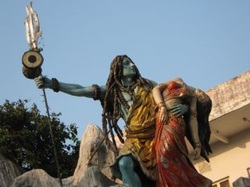
According to Hindu view of life, Shiva, the principle male power, unites with his female counterpart in order to acquire the ability to create and destroy. The story of Sati and Shiva, described in the Purana, presents in simple language, the truth and beauty of such a lofty vedic concept. In the days of ancient mythology, Brahma, the Prajapati, mentally created ten sons (manasa putra) to carry out his task of creation and destruction. Both Shiva and Daksha were the outcome of such a creation but Shiva had superior powers. Daksha, however, never liked the supremacy of Shiva. So, he took Shiva as his rival.
One of the daughters of Daksha, named Sati, was a great devotee of Shiva. She was beautiful and virtuous. Most of the time Sati immersed in the thoughts of Shiva and dreamed of being his wife.
Sati, through her sincere and devotional prayers, acquired the blessings of all gods and goddesses. Shiva finally yielded and appeared before Sati. She paid her reverence and kneeling down to Shiva chanted in praise of him.
Shiva asked her to choose a boon. Shiva knew what she would ask but wanted her to speak for herself.
Sati was hesitant, "How can I say that I want nothing else but Him!"
After a while Sati gathered her courage and started to say, "Lord will you ----"
Shiva did not let Sati complete her question, and he blessed her, "Be my consort Sati."
Soon Sati was married to Shiva amidst numerous gods and goddesses.
After the wedding, Shiva took Sati to Kailas where they spent many a happy days.
Then one day, Shiva requested Sati to accompany him to Prayag, today's Allahabad, to attend a fire- worship ceremony or Yagna.
When Shiva entered the Yagna hall, every one stood up to pay respect.
After some time Daksha entered the Yagna hall. Everyone stood up to pay respect except Shiva. Daksha felt insulted.
"How dare my son-in-law, Shiva, did not stand up! This is a deliberate insult to me," Daksha said to himself.
Shiva, on the other hand, thought to himself, "Being a superior power, it will not be nice if I stand up, and harm may befall on Daksha." Shiva did not mean to insult Daksha.
Taking this instance as an exception, Daksha promised to insult Shiva in public. He hurriedly returned home and declared that he will hold a grand sacrificial ceremony. He invited all gods and goddesses, but deliberately excluded Shiva.
When Sati, Shiva's beautiful wife and Daksha's daughter, noticed a large procession of gods and goddesses passing by, she curiously asked Shiva, "Where are they going?"
Shiva replied, "To the grand sacrificial ceremony to be held by Daksha, your father."
Sati was amazed.
"Then why have you not been invited?" she demanded angrily. "You should have been the first to be asked."
Shiva smiled gently at his wife's loyalty and fervor.
"Daksha has always been hostile to me," Shiva tried to explain.
But Sati's disbelief increased, "Does my father not realize that you are the supreme power and no one can equal you?"
"You are a good and true wife Sati," Shiva replied gently, "but Daksha thinks differently, he takes me as his rival."
"Invited or not," Sati said furiously, "I think we should go. It is after all my own father's house and I atleast need no invitation."
"Then go with my blessings Sati," replied Shiva. "but do not forget that Daksha will shower insults upon me. You must be strong enough to bear it silently and not allow your rage to show in your father's presence. If you are unable to tolerate his insults, I fear you may come to harm."
Taking Nandi, the gentle white bull who was Shiva's companion and mount, Sati arrived at her father's grand sacrificial ceremony.
Daksha reluctantly received her and publicly condemned Shiva - calling him the demon of death and an impious haunter of cremation grounds.
"What place has the goblin lord of witches and foul spirits in a sacred ceremony such as mine?" Daksha boomed.
Sati was hurt by his insults to her husband and begged her father to stop, but Daksha could not contain himself.
"It is disgraceful for a so-called god to wear filthy rags, cover himself with snakes and dance like a madman at ceremonies ---" continued Daksha on and on until Sati could not stand any longer. She remembered her husband's caution, "Do not allow your rage to get over you."
Sati painfully said, "I am ashamed to be known as your daughter. As I have promised my husband not to take any revenge, much less upon you, I merely denounce you before this assembly. I shall consume myself in a fire and return to mother Earth until I am born again to a father whom I can respect."
Daksha ignored the disappearance of Sati and ordered to continue with the sacrifice.
When news reached Shiva, through Nandi, that his beloved wife was dead, he let out a mighty roar that shook Heaven and Earth. He soon created a powerful demon, named Virabhadra, from his matted hair. Shiva also created a huge army of demons to accompany Virabhadra. They descended like a hurricane on Daksha's feast, destroying the sacrificial offering and killing all those who dared defend Daksha. Finally every one walked over to Shiva's side to seek refuge with him.
Shiva was about to destroy the universe, when Brahma came with other gods to calm him down. Shiva was still quivering and shook with wrath and grief at the loss of Sati. All the gods soothed the furious Shiva and pleaded with him to forgive Daksha and allow him to complete the sacrificial ceremony, which he had started, otherwise he would go to hell.
Relenting, Shiva brought back to life all the people who had been killed in the battle and cured all those who had been injured. Finally he looked up, suppressing the power of his destructive third eye, and stated, "I will return Daksha to life, but he must bear the mark of his foolishness forever."
The gods agreed to Shiva's condition and Daksha was revived. The mark of his foolishness was clear for all to see for instead of his own head, he wore the head of a goat. Daksha fell at Shiva's feet weeping with gratitude, and finally acknowledged Shiva's supremacy.
With a mighty effort Shiva contained his grief for the loss of Sati, and he fell into profound meditation, waiting for the time when she would be reincarnated as Parvati and be his wife once again.
One of the daughters of Daksha, named Sati, was a great devotee of Shiva. She was beautiful and virtuous. Most of the time Sati immersed in the thoughts of Shiva and dreamed of being his wife.
Sati, through her sincere and devotional prayers, acquired the blessings of all gods and goddesses. Shiva finally yielded and appeared before Sati. She paid her reverence and kneeling down to Shiva chanted in praise of him.
Shiva asked her to choose a boon. Shiva knew what she would ask but wanted her to speak for herself.
Sati was hesitant, "How can I say that I want nothing else but Him!"
After a while Sati gathered her courage and started to say, "Lord will you ----"
Shiva did not let Sati complete her question, and he blessed her, "Be my consort Sati."
Soon Sati was married to Shiva amidst numerous gods and goddesses.
After the wedding, Shiva took Sati to Kailas where they spent many a happy days.
Then one day, Shiva requested Sati to accompany him to Prayag, today's Allahabad, to attend a fire- worship ceremony or Yagna.
When Shiva entered the Yagna hall, every one stood up to pay respect.
After some time Daksha entered the Yagna hall. Everyone stood up to pay respect except Shiva. Daksha felt insulted.
"How dare my son-in-law, Shiva, did not stand up! This is a deliberate insult to me," Daksha said to himself.
Shiva, on the other hand, thought to himself, "Being a superior power, it will not be nice if I stand up, and harm may befall on Daksha." Shiva did not mean to insult Daksha.
Taking this instance as an exception, Daksha promised to insult Shiva in public. He hurriedly returned home and declared that he will hold a grand sacrificial ceremony. He invited all gods and goddesses, but deliberately excluded Shiva.
When Sati, Shiva's beautiful wife and Daksha's daughter, noticed a large procession of gods and goddesses passing by, she curiously asked Shiva, "Where are they going?"
Shiva replied, "To the grand sacrificial ceremony to be held by Daksha, your father."
Sati was amazed.
"Then why have you not been invited?" she demanded angrily. "You should have been the first to be asked."
Shiva smiled gently at his wife's loyalty and fervor.
"Daksha has always been hostile to me," Shiva tried to explain.
But Sati's disbelief increased, "Does my father not realize that you are the supreme power and no one can equal you?"
"You are a good and true wife Sati," Shiva replied gently, "but Daksha thinks differently, he takes me as his rival."
"Invited or not," Sati said furiously, "I think we should go. It is after all my own father's house and I atleast need no invitation."
"Then go with my blessings Sati," replied Shiva. "but do not forget that Daksha will shower insults upon me. You must be strong enough to bear it silently and not allow your rage to show in your father's presence. If you are unable to tolerate his insults, I fear you may come to harm."
Taking Nandi, the gentle white bull who was Shiva's companion and mount, Sati arrived at her father's grand sacrificial ceremony.
Daksha reluctantly received her and publicly condemned Shiva - calling him the demon of death and an impious haunter of cremation grounds.
"What place has the goblin lord of witches and foul spirits in a sacred ceremony such as mine?" Daksha boomed.
Sati was hurt by his insults to her husband and begged her father to stop, but Daksha could not contain himself.
"It is disgraceful for a so-called god to wear filthy rags, cover himself with snakes and dance like a madman at ceremonies ---" continued Daksha on and on until Sati could not stand any longer. She remembered her husband's caution, "Do not allow your rage to get over you."
Sati painfully said, "I am ashamed to be known as your daughter. As I have promised my husband not to take any revenge, much less upon you, I merely denounce you before this assembly. I shall consume myself in a fire and return to mother Earth until I am born again to a father whom I can respect."
Daksha ignored the disappearance of Sati and ordered to continue with the sacrifice.
When news reached Shiva, through Nandi, that his beloved wife was dead, he let out a mighty roar that shook Heaven and Earth. He soon created a powerful demon, named Virabhadra, from his matted hair. Shiva also created a huge army of demons to accompany Virabhadra. They descended like a hurricane on Daksha's feast, destroying the sacrificial offering and killing all those who dared defend Daksha. Finally every one walked over to Shiva's side to seek refuge with him.
Shiva was about to destroy the universe, when Brahma came with other gods to calm him down. Shiva was still quivering and shook with wrath and grief at the loss of Sati. All the gods soothed the furious Shiva and pleaded with him to forgive Daksha and allow him to complete the sacrificial ceremony, which he had started, otherwise he would go to hell.
Relenting, Shiva brought back to life all the people who had been killed in the battle and cured all those who had been injured. Finally he looked up, suppressing the power of his destructive third eye, and stated, "I will return Daksha to life, but he must bear the mark of his foolishness forever."
The gods agreed to Shiva's condition and Daksha was revived. The mark of his foolishness was clear for all to see for instead of his own head, he wore the head of a goat. Daksha fell at Shiva's feet weeping with gratitude, and finally acknowledged Shiva's supremacy.
With a mighty effort Shiva contained his grief for the loss of Sati, and he fell into profound meditation, waiting for the time when she would be reincarnated as Parvati and be his wife once again.
Ardhanishwar
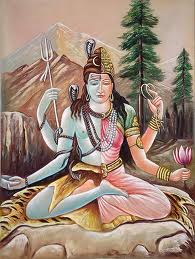
In the form of male and female, matted hair with moon, axe, smeared in red (aruNa), wearing snakes and the skin of tiger, embracing the bull and with a bent leg, this the right half, and the left black in color, hand holding a (lily) flower close to the chest, with a silk like lotus foot, wearing gold ornaments, salutations to the Half female God.
purANa of the deity ardha nAri Ishvarar : half female God (bhOga mUrti)
Sage bRingi is one of the ardent devotees of Lord shiva. He used to worship only Lord shiva and not shakti. Goddess shakti, being the power as the name indicate, pulled out the energy from bRingi mahaRishi's body. Now he was even unable to stand. He pleaded to God. God shiva provided him with a stick. On its support he stood and still worshipped Lord shiva alone. Goddess shakti wanted to become an inseparable part of Lord shiva's form. She oberved the kEdhAra mahA vrata (1) austerity, which is now known as deepAvaLi. Pleased with her austerity, Lord shiva granted her the boon of being part of His form. So the Lord now appeared male on the right side and female on the left side and hence became ardhanArIshvara.
Significance of this form This is one of the very important form of God, Hindus worship. This is a much-hailed form in scriptures of various languages. Hindus do not say that the God is only male. God is male - female and neuter too ! Since God is conceptually beyond sex, though gets referred as He/She many times, it is more appropriate to refer as It, especially at Its intrinsic condition, as do many hindu scriptures.
Philosophically, this form is quite associated with the Grace of God. shiva and shakti are one and the same Supreme. The formless God is called parashiva. On Its own free-will for the benefit of pashus (souls), which are drowned in pAsha (bondage), It thinks to create the worlds. Its dynamism of creation thus springs out of It, which is called shakti. Now shiva and Its power shakti create everything. This is the form of their togetherness that springs out of Lord shiva. Because of this the form is associated with the grace of God. shiva and shakti though the same may also act independently. They are associated like the person and the action of the person. They are one and the same like the ice and the water - one becomes the other. For this reason scriptures describe that shakti to shiva is a wife (they are together), mother (shakti becomes shiva - so shiva comes out of shakti) and daughter (shiva become shakti). Poet kAlidAsa hails them as inseparable like the word and its meaning, the letter and pronunciation !!
See Also:
1. kEdAra vratam
purANa of the deity ardha nAri Ishvarar : half female God (bhOga mUrti)
Sage bRingi is one of the ardent devotees of Lord shiva. He used to worship only Lord shiva and not shakti. Goddess shakti, being the power as the name indicate, pulled out the energy from bRingi mahaRishi's body. Now he was even unable to stand. He pleaded to God. God shiva provided him with a stick. On its support he stood and still worshipped Lord shiva alone. Goddess shakti wanted to become an inseparable part of Lord shiva's form. She oberved the kEdhAra mahA vrata (1) austerity, which is now known as deepAvaLi. Pleased with her austerity, Lord shiva granted her the boon of being part of His form. So the Lord now appeared male on the right side and female on the left side and hence became ardhanArIshvara.
Significance of this form This is one of the very important form of God, Hindus worship. This is a much-hailed form in scriptures of various languages. Hindus do not say that the God is only male. God is male - female and neuter too ! Since God is conceptually beyond sex, though gets referred as He/She many times, it is more appropriate to refer as It, especially at Its intrinsic condition, as do many hindu scriptures.
Philosophically, this form is quite associated with the Grace of God. shiva and shakti are one and the same Supreme. The formless God is called parashiva. On Its own free-will for the benefit of pashus (souls), which are drowned in pAsha (bondage), It thinks to create the worlds. Its dynamism of creation thus springs out of It, which is called shakti. Now shiva and Its power shakti create everything. This is the form of their togetherness that springs out of Lord shiva. Because of this the form is associated with the grace of God. shiva and shakti though the same may also act independently. They are associated like the person and the action of the person. They are one and the same like the ice and the water - one becomes the other. For this reason scriptures describe that shakti to shiva is a wife (they are together), mother (shakti becomes shiva - so shiva comes out of shakti) and daughter (shiva become shakti). Poet kAlidAsa hails them as inseparable like the word and its meaning, the letter and pronunciation !!
See Also:
1. kEdAra vratam
Virabhadra - Daksha's rites
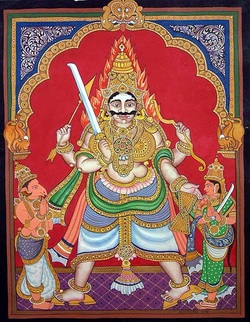
karALar (vIrabhadrar)
shlokam: With four shoulders, three eyed, with the matted hair wound as a crown, sword and arrow in His right hand, bow and mace in His left, with projecting teeth, with a frightening face, powerful, with a terrible roar, accompanied by bhadrakALi, (I) think of that karALa.
purANa of the deity karAlar: dreadful one (vIra mUrthi)
shakti as dAkshAyaNi appeared as the daughter of daksha, who was the son of brahmA. She prayed Lord Shiva to get married to Him. The Lord accepted dAshAyaNi ignoring the ostentation of daksha. daksha felt insulted as the Lord did not get married to his daughter with his pompous arrangements. He did a yAga in which he worshipped all gods and purposefully ignored the God, Shiva. All other dEvAs out of their fear attended the yAga and accepted the offering. A great sage dadhIchi advised dakshA not to do such things and warned him it will be fatal for him. Ignoring his advice, dakshA continued his yAga. dAkshAyaNi came to the yAga to advise Her father to do offering to the Lord of gods, Shiva. But he ignored Her advice and accused Her and Lord Shiva. She got angry and prayed the Lord to teach dakshA a lesson, left the form of dAkshAyaNi by getting into the yAga fire and appeared as the daughter of king of Himalayas (see kaLyANa su.ndarar).
The Lord created vIra bhadrar(also called karALar) and bhadra kALi. (karALar is the only deity in the 25 mAhEshwara mUrtis, who is not Lord Shiva Himself, but is a power of Lord Shiva). Lord asked them to destroy the yAga of dakshA. They stormed into the yAga and mutilated the dEvAs who took part in the yAga. He cut the head of dakshA. Nobody could stop Him. (A more detailed description can be found in daksha kAnDam of kan^da purANam (1). thiruvun^dhiyAr(2) in thiruvAcakam sings this victory. thakkayAgap paraNi (3) is a literature dedicated to this storming by the valorous vIrabhadra). Lord viShNu came for a fight, but in vain. All the dEvAs surrendered to Lord Shiva and pleaded for mercy. The Giver of refuge, forgave them and on their request gave dakshA also life by putting the head of a goat in place of his cut head. dakshA repented for his sin. thirup paRiyalUr is the temple associated with the destruction of daksha yAgam
See Also:
shlokam: With four shoulders, three eyed, with the matted hair wound as a crown, sword and arrow in His right hand, bow and mace in His left, with projecting teeth, with a frightening face, powerful, with a terrible roar, accompanied by bhadrakALi, (I) think of that karALa.
purANa of the deity karAlar: dreadful one (vIra mUrthi)
shakti as dAkshAyaNi appeared as the daughter of daksha, who was the son of brahmA. She prayed Lord Shiva to get married to Him. The Lord accepted dAshAyaNi ignoring the ostentation of daksha. daksha felt insulted as the Lord did not get married to his daughter with his pompous arrangements. He did a yAga in which he worshipped all gods and purposefully ignored the God, Shiva. All other dEvAs out of their fear attended the yAga and accepted the offering. A great sage dadhIchi advised dakshA not to do such things and warned him it will be fatal for him. Ignoring his advice, dakshA continued his yAga. dAkshAyaNi came to the yAga to advise Her father to do offering to the Lord of gods, Shiva. But he ignored Her advice and accused Her and Lord Shiva. She got angry and prayed the Lord to teach dakshA a lesson, left the form of dAkshAyaNi by getting into the yAga fire and appeared as the daughter of king of Himalayas (see kaLyANa su.ndarar).
The Lord created vIra bhadrar(also called karALar) and bhadra kALi. (karALar is the only deity in the 25 mAhEshwara mUrtis, who is not Lord Shiva Himself, but is a power of Lord Shiva). Lord asked them to destroy the yAga of dakshA. They stormed into the yAga and mutilated the dEvAs who took part in the yAga. He cut the head of dakshA. Nobody could stop Him. (A more detailed description can be found in daksha kAnDam of kan^da purANam (1). thiruvun^dhiyAr(2) in thiruvAcakam sings this victory. thakkayAgap paraNi (3) is a literature dedicated to this storming by the valorous vIrabhadra). Lord viShNu came for a fight, but in vain. All the dEvAs surrendered to Lord Shiva and pleaded for mercy. The Giver of refuge, forgave them and on their request gave dakshA also life by putting the head of a goat in place of his cut head. dakshA repented for his sin. thirup paRiyalUr is the temple associated with the destruction of daksha yAgam
See Also:
Bhikshatanar
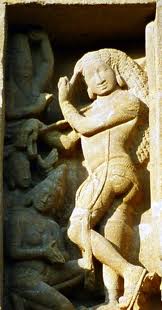
Smeared in white, with good omen in eyes, fingers with grass to the right, with shUla and kapAla in the left lands, nice wear (pAduka) in feet, with dangling red matted hair, moon on the head, deer (mR^igam) in the right hand, a vessel for alms in the left, with bulged belly, that God, on bhikshAtana, we pray.
Description of the deity : bhikshAtanar : The mUrti who asks for alms
The R^ishis in dArukAvanam forest, once thought that only the karma(deed, performing rituals) is supreme and it is not required to pray God at all. They stopped worshipping God. Whatever be the deeds, isn't there One Who provides the doer with the fruits ? How can the inanimate deeds automatically give fruit ? Not realizing these facts the R^iShis pursued their dogma of karma. To teach them the importance of worship Lord Shiva took the form of bhikshAtanar (begger) and mahA vishNu the form of mOhini (glamorous girl). In this form the Lord is naked and quite enchanting. So was the mohini. The Naked Lord came to the streets of the R^iShis to get alms. (Does the God, Who is the provider of all wealth, need to beg ? The playful Lord, while providing the supreme wealth for those who worship, went to beg as if He has nothing !) At the charm of the naked Lord Shiva the wives of the R^ishis lost their heart. They forgot what they were doing and started simply following the Naked God. Meanwhile the R^ishis also forgot the karma they were strongly advocating and followed the glamorous mOhini.
When they got to see their wives - the followers of karmic discipline, lost their virtue and following a Naked Beggar, they got angry with Lord Shiva and vishNu and started targeting their power of the karmas towards the Lord, by performing the abhichAra yAgam which will produce bad effects. They directed the snakes, demon, tiger, fire and drum that came out of the fire against the Lord. What can hurt the Supreme Who is the Source of everything. He coolly made them his ornaments! Now the R^iShis realized their stupidity and realized that God is the supreme and not the karma.
Description of the deity : bhikshAtanar : The mUrti who asks for alms
The R^ishis in dArukAvanam forest, once thought that only the karma(deed, performing rituals) is supreme and it is not required to pray God at all. They stopped worshipping God. Whatever be the deeds, isn't there One Who provides the doer with the fruits ? How can the inanimate deeds automatically give fruit ? Not realizing these facts the R^iShis pursued their dogma of karma. To teach them the importance of worship Lord Shiva took the form of bhikshAtanar (begger) and mahA vishNu the form of mOhini (glamorous girl). In this form the Lord is naked and quite enchanting. So was the mohini. The Naked Lord came to the streets of the R^iShis to get alms. (Does the God, Who is the provider of all wealth, need to beg ? The playful Lord, while providing the supreme wealth for those who worship, went to beg as if He has nothing !) At the charm of the naked Lord Shiva the wives of the R^ishis lost their heart. They forgot what they were doing and started simply following the Naked God. Meanwhile the R^ishis also forgot the karma they were strongly advocating and followed the glamorous mOhini.
When they got to see their wives - the followers of karmic discipline, lost their virtue and following a Naked Beggar, they got angry with Lord Shiva and vishNu and started targeting their power of the karmas towards the Lord, by performing the abhichAra yAgam which will produce bad effects. They directed the snakes, demon, tiger, fire and drum that came out of the fire against the Lord. What can hurt the Supreme Who is the Source of everything. He coolly made them his ornaments! Now the R^iShis realized their stupidity and realized that God is the supreme and not the karma.
The end of Kama (lust) - God of Love
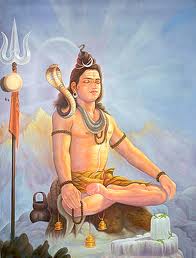
shlokam: The body smeared with ash, moon on the head, ornated by gangA, snakes, axe and deer, Pure, sitting comfortably in vIrAsanam, with the left palm over the right, in the posture of a yOgi, wearing the skin of a tiger, burning the cupid with the fire emerging from the eye in the forehead, to You salutations.
Description of the deity: kAma ari : one who is the enemy of cupid.(vIra mUrti)
When Shakthi became pArvati, daughter of the king of Himalayas, She was doing thapas for Lord Shiva. (1) At the same time the great sages, the four sons of Brahma, sanakar, sana.ndanar, sanAtanar, sanat kumArar came to Lord Shiva for enlightenment. The Lord gave them enlightenment in the form of Lord dakshiNA mUrti.(2) As the Duo, Who are the cause as well as the energy for the whole world are into yoga, the whole world got more inclined to yoga and life sustenance was in trouble. Meanwhile the dEvas, who were tortured by the sUrapadma and his brothers tAraka, simhamukha, knew that those demons can be killed only by the son of Lord Shiva and Shakthi. Disappointed that both God and Goddess were doing yoga instead of marrying, they asked the cupid to disturb the meditating Lord Shiva with his arrows in order to induce lust for pArvati. When desperation sets in, reasoning gets pushed down. Can the Supreme be induced with lust by anybody ? The cupid refused since he knew that it will be just fatal for him. But the other dEvAs threatened to curse him if he didn't obey. Saying that it is better to be killed by the God of gods than by the curses of dEvAs, he went with his wife, rati, to the abode of Shiva where He was in meditation.
The cupid shot the flower arrow on the Lord. The next moment the fire from the eye in the forehead of the Lord burnt the cupid. Undisturbed He continued His meditation. The cupid is of the reputation that his arrows never fail. But well, it can apply to others, can it be for the Almighty ? His arrows were useless in front of the Lord and he too became just a heap of ash ! Shocked by the death of cupid all the dEvAs realized their plots would not work out with God. They understood that only sincerity could get the showers of Its grace and any other pressure can just not mount over God. They surrendered themselves in front of the Lord and pleaded for mercy. The Lord forgave them and married pArvati and gave subrahmaNya for the destruction of the demons. On their request He also bring back to life kAma, however he would be visible only to his wife and not to others. Because of this reason kAmadeva is called ananga (one without limbs).
thiruk kuRikkai is the temple associated with the burning of god of lust.
Description of the deity: kAma ari : one who is the enemy of cupid.(vIra mUrti)
When Shakthi became pArvati, daughter of the king of Himalayas, She was doing thapas for Lord Shiva. (1) At the same time the great sages, the four sons of Brahma, sanakar, sana.ndanar, sanAtanar, sanat kumArar came to Lord Shiva for enlightenment. The Lord gave them enlightenment in the form of Lord dakshiNA mUrti.(2) As the Duo, Who are the cause as well as the energy for the whole world are into yoga, the whole world got more inclined to yoga and life sustenance was in trouble. Meanwhile the dEvas, who were tortured by the sUrapadma and his brothers tAraka, simhamukha, knew that those demons can be killed only by the son of Lord Shiva and Shakthi. Disappointed that both God and Goddess were doing yoga instead of marrying, they asked the cupid to disturb the meditating Lord Shiva with his arrows in order to induce lust for pArvati. When desperation sets in, reasoning gets pushed down. Can the Supreme be induced with lust by anybody ? The cupid refused since he knew that it will be just fatal for him. But the other dEvAs threatened to curse him if he didn't obey. Saying that it is better to be killed by the God of gods than by the curses of dEvAs, he went with his wife, rati, to the abode of Shiva where He was in meditation.
The cupid shot the flower arrow on the Lord. The next moment the fire from the eye in the forehead of the Lord burnt the cupid. Undisturbed He continued His meditation. The cupid is of the reputation that his arrows never fail. But well, it can apply to others, can it be for the Almighty ? His arrows were useless in front of the Lord and he too became just a heap of ash ! Shocked by the death of cupid all the dEvAs realized their plots would not work out with God. They understood that only sincerity could get the showers of Its grace and any other pressure can just not mount over God. They surrendered themselves in front of the Lord and pleaded for mercy. The Lord forgave them and married pArvati and gave subrahmaNya for the destruction of the demons. On their request He also bring back to life kAma, however he would be visible only to his wife and not to others. Because of this reason kAmadeva is called ananga (one without limbs).
thiruk kuRikkai is the temple associated with the burning of god of lust.
Tripurantakar
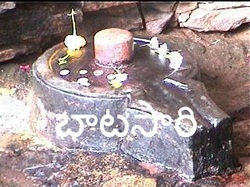
Smeared in red (blood), a full-moon face, with the deer, and the bow to the left (in His hand), in the right hand an arrow and axe, wearing ga.nga and crescent moon, always worshipped by vishNu and brahma, burnt the three cities by His smile, to that God of three worlds, the enemy of pura (purAri), pray.
purANa of the deity : tri pura a.ntakar : destroyer of three cities (vIra mUrti)
The tripurA signify the three components(impurities) of bondage (pAsam) namely aham (ego), karma(deeds and their effects), mAya (illusion). When God shows His grace all these impurities are burnt, bliss remains and Lord Shiva dances there. (padhi aNukiR pachu pAcha n^illAvE - thirumUlar)
Three demons kamalAkshan, tArukAkshan, vidhunmAli got a boon from the Lord that they can not be destroyed unless all three of them come together, and attacked by a single arrow. Then they created forts in different areas and ruled the world. dEvAs who were disturbed by them complained it to the Lord. But Lord Shiva said as long as the three demons pray Him He won't destroy them. So mahA vishNu took the form of a sage, and taught the three demons mAyAvAtham, resulting them to stop praying the Lord, praising themselves and torturing dEvAs. Since all the good qualities of them were lost the Lord came for the destruction of the purAs. The three demons came together to fight against the Lord forgetting their boon.
The earth became the chariot for the Lord, brahma the charioteer, vishNu the arrow, sun and moon the wheels, the mountain mEru as the bow and the serpent vAsuki as the string in the bow. Thus all the gods were present in some form in that chariot. But the fire and god of death were in the wheel instead of the arrow. vinAyaka broke the wheel to put them in the arrow. Finally when everything was ready dEvAs were proud that only with their help God is going to destroy the tripuras. But Lord Shiva didn't use any of them. He smiled and in that smile the three purAs were burnt down.(The rudhrAksha appeared from the three eyes of Lord Shiva during tripurasaMhAra) The thought of dEvAs that without their help the Lord wont be able to destroy the tripuras proved foolish.
The purpose of destruction by Lord is only for purification. Lord gave life to the three demons. Though they went wrong they initially were devotees. They repented for their mistake. The Lord forgave them and gave one of them the great work of fanning Him with chAmaram, and the rest two as His security in His abode. (mUvAr puraN^kaL eriththa anRu mUvarkku aruL cheydhAn - thiru nyAna chamban^dhar)
purANa of the deity : tri pura a.ntakar : destroyer of three cities (vIra mUrti)
The tripurA signify the three components(impurities) of bondage (pAsam) namely aham (ego), karma(deeds and their effects), mAya (illusion). When God shows His grace all these impurities are burnt, bliss remains and Lord Shiva dances there. (padhi aNukiR pachu pAcha n^illAvE - thirumUlar)
Three demons kamalAkshan, tArukAkshan, vidhunmAli got a boon from the Lord that they can not be destroyed unless all three of them come together, and attacked by a single arrow. Then they created forts in different areas and ruled the world. dEvAs who were disturbed by them complained it to the Lord. But Lord Shiva said as long as the three demons pray Him He won't destroy them. So mahA vishNu took the form of a sage, and taught the three demons mAyAvAtham, resulting them to stop praying the Lord, praising themselves and torturing dEvAs. Since all the good qualities of them were lost the Lord came for the destruction of the purAs. The three demons came together to fight against the Lord forgetting their boon.
The earth became the chariot for the Lord, brahma the charioteer, vishNu the arrow, sun and moon the wheels, the mountain mEru as the bow and the serpent vAsuki as the string in the bow. Thus all the gods were present in some form in that chariot. But the fire and god of death were in the wheel instead of the arrow. vinAyaka broke the wheel to put them in the arrow. Finally when everything was ready dEvAs were proud that only with their help God is going to destroy the tripuras. But Lord Shiva didn't use any of them. He smiled and in that smile the three purAs were burnt down.(The rudhrAksha appeared from the three eyes of Lord Shiva during tripurasaMhAra) The thought of dEvAs that without their help the Lord wont be able to destroy the tripuras proved foolish.
The purpose of destruction by Lord is only for purification. Lord gave life to the three demons. Though they went wrong they initially were devotees. They repented for their mistake. The Lord forgave them and gave one of them the great work of fanning Him with chAmaram, and the rest two as His security in His abode. (mUvAr puraN^kaL eriththa anRu mUvarkku aruL cheydhAn - thiru nyAna chamban^dhar)
Arjuna gets a weapon (Kirata, Lord Shiva as a hunter)
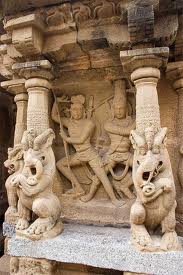
Body black in color, two shoulders holding bows and arrows, hair falling on the forehead, posing comfortably, with two piercing eyes, blossomed nice face, with feathers and fragrant flowers in his head, wearing the skin of tiger, Terrific, I meditate that Hunter (kirAta), the thief (hara).
purANa of the deity kirAtar : the hunter
This is the only form of Lord Shiva in which He appeared black in color. arjuna wanted to get the peerless weapon pAsupatAstram from Lord Shiva for the battle of mahAbharata. He left the other four pANdavAs, went to the forest and did austere tapas for getting the boon of Lord Shiva. Lord Shiva was satisfied with his prayer, wanted to give the pAsupatAstram to him, but wanted to play a bit too. He took the form of a Hunter with Shakthi as Huntress. That time a demon by name mUkAsura, who was in the form of wild pig came to kill arjuna. To kill the wild pig arjuna fired an arrow from the front, at the same time the Hunter, Who is none other than God Himself, attacked it from the back and killed the pig.
arjuna mocked at the Hunter for firing the arrow from the back. Having great pride of his valor, he was als angry at the Hunter because He aimed at his prey. The Hunter responded that attacking an animal from the back is not against rules of hunting. An argument broke out. They decided to fight deciding who was more valorous between them. The Hunter cut the string in arjuna's bow with His arrow in the fight! Angered and excited, arjuna started wrestling. He couldn't match the Lord, and the Lord enjoyed his fighting. At one point of time in wrestling arjuna held the foot of the Hunter. As the Lord is pleased when somebody catches His holy feet, He stopped wrestling appeared with pArvati revealing Who He is. Shocked arjuna pleaded for forgiveness, as he was trying to fight with the Supreme out of his ignorance. However the God, Who is pleased by devotion, blessed him and gave him the invincible pAsupatAstra. (In some books it is told that arjuna couldn't fight with the Hunter, he started worshipping the Shiva Lingam. To his astonishment he found the flowers he offered to the Lingam on the head of the Hunter. Then he prostrated before the Hunter and the Lord revealed Himself). This can be found in detail in kirAtArjuniyam of bhAravi and mahA bhArata.
purANa of the deity kirAtar : the hunter
This is the only form of Lord Shiva in which He appeared black in color. arjuna wanted to get the peerless weapon pAsupatAstram from Lord Shiva for the battle of mahAbharata. He left the other four pANdavAs, went to the forest and did austere tapas for getting the boon of Lord Shiva. Lord Shiva was satisfied with his prayer, wanted to give the pAsupatAstram to him, but wanted to play a bit too. He took the form of a Hunter with Shakthi as Huntress. That time a demon by name mUkAsura, who was in the form of wild pig came to kill arjuna. To kill the wild pig arjuna fired an arrow from the front, at the same time the Hunter, Who is none other than God Himself, attacked it from the back and killed the pig.
arjuna mocked at the Hunter for firing the arrow from the back. Having great pride of his valor, he was als angry at the Hunter because He aimed at his prey. The Hunter responded that attacking an animal from the back is not against rules of hunting. An argument broke out. They decided to fight deciding who was more valorous between them. The Hunter cut the string in arjuna's bow with His arrow in the fight! Angered and excited, arjuna started wrestling. He couldn't match the Lord, and the Lord enjoyed his fighting. At one point of time in wrestling arjuna held the foot of the Hunter. As the Lord is pleased when somebody catches His holy feet, He stopped wrestling appeared with pArvati revealing Who He is. Shocked arjuna pleaded for forgiveness, as he was trying to fight with the Supreme out of his ignorance. However the God, Who is pleased by devotion, blessed him and gave him the invincible pAsupatAstra. (In some books it is told that arjuna couldn't fight with the Hunter, he started worshipping the Shiva Lingam. To his astonishment he found the flowers he offered to the Lingam on the head of the Hunter. Then he prostrated before the Hunter and the Lord revealed Himself). This can be found in detail in kirAtArjuniyam of bhAravi and mahA bhArata.
Parvati's wedding - Shiva as Kalyasundaram
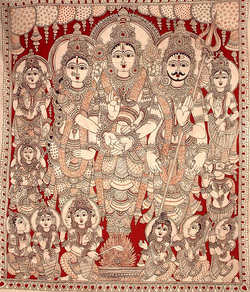
Shlokam: Red in color (si.ndhUram), Three eyed, shoulders like yugas (four shouldered), wearing necklace and bracelet, Colorful in divine wonderful dress, Shining in the wedding robe, ornated, with enchanting body, salutations to that mUrti who is in marriage posture, with a hand of dEvi in one lotus hand, with axe and deer in hands and ga.nga and moon on the wound-up hair.
purANa of the mUrti: kalyANa su.ndarar : The beautiful (mUrti )in marriage(bhOga mUrti)
Shakthi was born as pArvati, the daughter of the king of Himalayas. As a young child, She was not interested in playing like the other children. She was more inclined towards meditating on Lord Shiva in the mountains. She desired to marry Lord shiva. For that she wanted to perform austerity in the snow covered himalayas. Her parents hesitated, but finally had to subdue to the determination of pArvati. pArvati performed austerity from an ashram. Lord Shiva who was happy with Her worship, came as an old devotee to her place. pArvati offered Her respect to the Old bhakta of Her Beloved Lord. Now, He tried to convince Her that She shouldn't waste Her youth doing tapas, but should enjoy life getting married ! He further suggested that She could get married to Him, instead of desiring for Lord shiva Who dances in the cemeteries and wears skulls and bones! pArvati, without knowing that He is God Himself, got very angry on hearing the Old man's words and told Him that She showed Him respect only because He seemed like a devotee and She would not want to hear any little blasphemy of God further. She asked the Old Man to leave the place immediately. The Lord, pleased with Her determination and devotion, revealed who He is. pArvati was surprised and begged the pardon of God. However God had accepted Her scolding as the most pleasant hailing. Didn't it come from a very deep love for God ?! He gave Her the boon She yearned for - getting married to Her.
The himalayan king's family was delighted to see their beloved daughter's wedding. The region was decorated and shining with prosperity. The young beautiful pArvati was decorated with chosen best ornaments for the wedding. Now came the Groom - Lord shiva - to the wedding place - on an old bull, with skull and bone ornaments, with the skin of the tiger as the clothing, accompanied by the roar of the bUta gaNas !! The mother of pArvati mEnai fainted to see the groom in such a form for her sweet daughter, softer than the flowers. Now the Lord changed to the form, glittering in a beautiful wedding robe - with golden ornaments and splendid clothing! When mEnai woke up and saw the Groom she was thrilled to see such a beautiful form and was very pleased that He is "the suitable" groom for her daughter. The play of the Lord has no bounds ! mEnai saw only the external appearance of the Groom. Other than the great pArvati who knows the glory of that Groom ?! The enchanting Lord in the wedding robe got married to the Daughter of the mountains and this form of God is called kalyANa sundharar.
See Also:
purANa of the mUrti: kalyANa su.ndarar : The beautiful (mUrti )in marriage(bhOga mUrti)
Shakthi was born as pArvati, the daughter of the king of Himalayas. As a young child, She was not interested in playing like the other children. She was more inclined towards meditating on Lord Shiva in the mountains. She desired to marry Lord shiva. For that she wanted to perform austerity in the snow covered himalayas. Her parents hesitated, but finally had to subdue to the determination of pArvati. pArvati performed austerity from an ashram. Lord Shiva who was happy with Her worship, came as an old devotee to her place. pArvati offered Her respect to the Old bhakta of Her Beloved Lord. Now, He tried to convince Her that She shouldn't waste Her youth doing tapas, but should enjoy life getting married ! He further suggested that She could get married to Him, instead of desiring for Lord shiva Who dances in the cemeteries and wears skulls and bones! pArvati, without knowing that He is God Himself, got very angry on hearing the Old man's words and told Him that She showed Him respect only because He seemed like a devotee and She would not want to hear any little blasphemy of God further. She asked the Old Man to leave the place immediately. The Lord, pleased with Her determination and devotion, revealed who He is. pArvati was surprised and begged the pardon of God. However God had accepted Her scolding as the most pleasant hailing. Didn't it come from a very deep love for God ?! He gave Her the boon She yearned for - getting married to Her.
The himalayan king's family was delighted to see their beloved daughter's wedding. The region was decorated and shining with prosperity. The young beautiful pArvati was decorated with chosen best ornaments for the wedding. Now came the Groom - Lord shiva - to the wedding place - on an old bull, with skull and bone ornaments, with the skin of the tiger as the clothing, accompanied by the roar of the bUta gaNas !! The mother of pArvati mEnai fainted to see the groom in such a form for her sweet daughter, softer than the flowers. Now the Lord changed to the form, glittering in a beautiful wedding robe - with golden ornaments and splendid clothing! When mEnai woke up and saw the Groom she was thrilled to see such a beautiful form and was very pleased that He is "the suitable" groom for her daughter. The play of the Lord has no bounds ! mEnai saw only the external appearance of the Groom. Other than the great pArvati who knows the glory of that Groom ?! The enchanting Lord in the wedding robe got married to the Daughter of the mountains and this form of God is called kalyANa sundharar.
See Also:
Protecting Markandeya from death - Shiva as Kalari
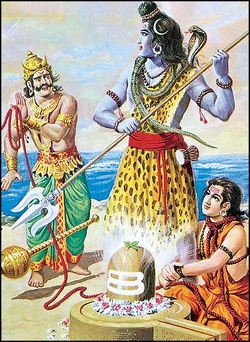
Red in color (sin^dhUram), Three eyed, shoulders like yugas (four shouldered), with hands holding up the sUlam , noose, axe in hands, with frightening teeth, nice face, with the left foot standing up over the chest of kAla (time - death), with cast down red matted hair, to that pashupati(Lord of creatures), kAlAn^taka I prostrate.
purANa of the deity: kAla ari : The enemy of kALa(vIra mUrti)
kAla is the dEva who is responsible for death. Taking the kAla as time it can be said kAlari represents the fact that God is beyond the limits of time (mR^ityuJNjayan).
The sage mR^ikaNDu did not have an offspring for quite a long time. He performed tapas to get the blessings of Lord shiva. God appeared in front of him. Now the sage had two choices - either a son indiscipline, cruel and dumb living for long or a son loving, intelligent and a gem of character living very short span of life. The sage chose the second one. His wife gave birth to a child mArkaNDEya, out of a boon from Lord Shiva, by which mArkaNDEya would be very intelligent but would live just for 16 years.
Young child mArkaNDEya grew up learning the great scriptures, caring and loving, devotional towards God. His parents were very pleased with him. When he became 16, he found his parents weeping. He came to know that he would die at 16 and that was the cause of the gloom. Intelligent mArkanDeya realized that none other than the God, Who is beyond all the scopes of time and hailed as mR^ityuNJjaya - who conquered the death, can save him from the strong clutches of death. Determined and devotional, he started doing Shiva pUja and surrendered himself completely to the Lord. The yamadUtAs who came to take his life away were scared away by the flame of this young boy's devotion. As the the attendants couldn't take away his life, kAla the god of death, himself came. Young mArkaNDEya did not loose his devotion even in the crisis moment. He embraced the shiva liN^gam. As kAla still tried to take away mArkaNDEya's life, the Lord appeared furious from the Shiva liN^gam and kicked kAla to death!! He blessed the sincere devotion of the young boy and made mArkaNDEya to be in 16 always - deathless !
All the gods pleaded to Lord to show mercy on kAla. On their request, God gave kAla life back and ordered him not to disturb His devotees.
purANa of the deity: kAla ari : The enemy of kALa(vIra mUrti)
kAla is the dEva who is responsible for death. Taking the kAla as time it can be said kAlari represents the fact that God is beyond the limits of time (mR^ityuJNjayan).
The sage mR^ikaNDu did not have an offspring for quite a long time. He performed tapas to get the blessings of Lord shiva. God appeared in front of him. Now the sage had two choices - either a son indiscipline, cruel and dumb living for long or a son loving, intelligent and a gem of character living very short span of life. The sage chose the second one. His wife gave birth to a child mArkaNDEya, out of a boon from Lord Shiva, by which mArkaNDEya would be very intelligent but would live just for 16 years.
Young child mArkaNDEya grew up learning the great scriptures, caring and loving, devotional towards God. His parents were very pleased with him. When he became 16, he found his parents weeping. He came to know that he would die at 16 and that was the cause of the gloom. Intelligent mArkanDeya realized that none other than the God, Who is beyond all the scopes of time and hailed as mR^ityuNJjaya - who conquered the death, can save him from the strong clutches of death. Determined and devotional, he started doing Shiva pUja and surrendered himself completely to the Lord. The yamadUtAs who came to take his life away were scared away by the flame of this young boy's devotion. As the the attendants couldn't take away his life, kAla the god of death, himself came. Young mArkaNDEya did not loose his devotion even in the crisis moment. He embraced the shiva liN^gam. As kAla still tried to take away mArkaNDEya's life, the Lord appeared furious from the Shiva liN^gam and kicked kAla to death!! He blessed the sincere devotion of the young boy and made mArkaNDEya to be in 16 always - deathless !
All the gods pleaded to Lord to show mercy on kAla. On their request, God gave kAla life back and ordered him not to disturb His devotees.
Slaying of Jalandhar - Shiva as Jalandari
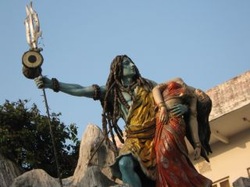
In
Vishnu's Chakra
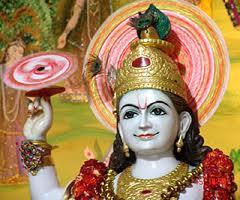
Dhyana shlokam of chakra prada murthi : In one side vishNu, standing with folded hands, offering at the Feet of the Divine one of his eyes to complete (the shortfall) a thousand lotuses, from Which Lord got the disc weapon(chakra) and the blessing order to be renowned as lotus-eyed, that Lord of Creatures (pashupati) with axe, deer, boon giving posture, to that giver of disc, salutations.
purANa of the chakra dhAna Murthi: chakra pradar : The giver of disc (bhOga mUrti)
For the protection of the world mahA vishNu wanted to have a weapon that is very powerful. He wanted to worship Lord Shiva with thousand flowers to get the the sudarshana disc, which was created by Lord shiva for jala.ndhara samhAra. mahA viShNu collected the required flowers and started the worship. But during the worship, mahA vishNu found that he fell short of one flower to thousand. He did not want to stop at any cost the worship of Lord shiva. Immediately he plucked out and offered one of the eyes as the thousandth flower. Delighted by that devotion, Lord Shiva gave the disc to viShNu. Also mahA vishNu got the name "lotus eyed" (padmAksha) due to the devotion in offering the eye to make up for a lotus.
However the chakra was too powerful for viShNu to hold. So God made it into three parts, one given to viShNu, one to shakti and one kept with Himself. With that chakra the reverend Lord viShNu is protecting all the worlds. The form of Lord shiva blessing viShNu with the disc is the chakra prada mUrthi.
purANa of the chakra dhAna Murthi: chakra pradar : The giver of disc (bhOga mUrti)
For the protection of the world mahA vishNu wanted to have a weapon that is very powerful. He wanted to worship Lord Shiva with thousand flowers to get the the sudarshana disc, which was created by Lord shiva for jala.ndhara samhAra. mahA viShNu collected the required flowers and started the worship. But during the worship, mahA vishNu found that he fell short of one flower to thousand. He did not want to stop at any cost the worship of Lord shiva. Immediately he plucked out and offered one of the eyes as the thousandth flower. Delighted by that devotion, Lord Shiva gave the disc to viShNu. Also mahA vishNu got the name "lotus eyed" (padmAksha) due to the devotion in offering the eye to make up for a lotus.
However the chakra was too powerful for viShNu to hold. So God made it into three parts, one given to viShNu, one to shakti and one kept with Himself. With that chakra the reverend Lord viShNu is protecting all the worlds. The form of Lord shiva blessing viShNu with the disc is the chakra prada mUrthi.
Elephant's death by Lord Shiva
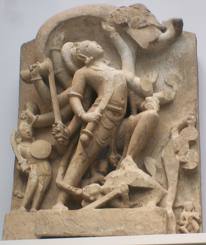
Standing on the head of the elephant with the right leg, with the hands ripping open the skin (of the elephant) and covering Himself with it, holding dreadful trident and sharungam, axe, and deer, boon giving posture in hands, with a frightening face, lit by the crescent, with the scared faced (pArvati) to the left, with a pointing hand, to that hara (salutations).
purANa of the deity : mAtaN^ga ari : enemy of the elephant (vIra mUrti)
There was a demon gajAsura in the form of an elephant. He did severe penance and got lots of powerful boons. His wicked mind did not try to use all those powers for the constructive things, but rather started to disturb, kill and loot others. The power he had got out of the penance made even the divines afraid of him. His crooked mind also brought him to the death trap, when he started to attack the devotees who were completely focused on the worship of God at the holy abode kAshi. His ego and mad rage made him not realize whom he is attacking. The Supreme Powerful God, the Protector of the devotees destroyed the demon ripping its body. The daemon screamed loud and lost the life.
Considered to be a very furious form of Lord Shiva, with the shakti Herself frightened by the act of the Lord. (However the Lord is in all smiles !)
pazuvUr is the temple associated with this valourous de
purANa of the deity : mAtaN^ga ari : enemy of the elephant (vIra mUrti)
There was a demon gajAsura in the form of an elephant. He did severe penance and got lots of powerful boons. His wicked mind did not try to use all those powers for the constructive things, but rather started to disturb, kill and loot others. The power he had got out of the penance made even the divines afraid of him. His crooked mind also brought him to the death trap, when he started to attack the devotees who were completely focused on the worship of God at the holy abode kAshi. His ego and mad rage made him not realize whom he is attacking. The Supreme Powerful God, the Protector of the devotees destroyed the demon ripping its body. The daemon screamed loud and lost the life.
Considered to be a very furious form of Lord Shiva, with the shakti Herself frightened by the act of the Lord. (However the Lord is in all smiles !)
pazuvUr is the temple associated with this valourous de
Ganges on Lord Shiva's jata
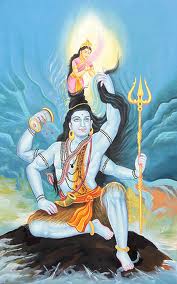
ga.ngA dharar : Lord wearing ga.ngA (river to head).
bhagIratha was the renowned king forefather of rAma of raghu vamsa. His forefathers known as sagaras were burnt down due to a curse. For the upliftment of those ancestors from the cursed state to get to the heavens, he wanted to bring the river ga.ngA to earth. The idea is that when ganga waters touch the ash of sagaras, they would be uplifted from their sin. He did very severe austerities and to get the permission from indra. He gave permission to bring the ganaga flowing in the heaven to the earth, however he told, coming down to earth would be the decision of ganga. So bagIrata again started his penance and prayed the goddess ga.ngA. She agreed to come down, but warned him that he should find a person who could withstand the force with which she will descend to earth! He agreed and found out that the refuge would be at Lord shiva. He did the austerities pleasing Lord Shiva. Appreciating his devotion and efforts, Lord agreed to hold the ga.ngA when she descends to earth. ga.ngA out of her pride and ignorance thought that the Lord won't be able to withstand the force! She came down with an intention to gush down the Lord with heavy force. Can the Lord, Who holds the entire world He created, be pushed down by a river ? The Lord, who is the creator of the entire universe and who has taken the forms just out of the grace on creatures, arrested her flow in His matted hair! She tried her best to rush out of His matted hair, but in vain. Not a drop of water could escape! bhagIratha, worried by this (as he would not get ganga to earth otherwise), prayed to the Lord to show mercy on her. The Gracious Lord allowed the ga.ngA through a strand of His matted hair. ga.ngA then flowed humbly, gracefully and giving prosperity on her way to pAtALa. Thus the ancestors of bhagIratha were resurrected by the holy water of ga.ngA.
The Lord in the posture holding the ganga in the matted hair is called gangAdhara mUrthi.
bhagIratha was the renowned king forefather of rAma of raghu vamsa. His forefathers known as sagaras were burnt down due to a curse. For the upliftment of those ancestors from the cursed state to get to the heavens, he wanted to bring the river ga.ngA to earth. The idea is that when ganga waters touch the ash of sagaras, they would be uplifted from their sin. He did very severe austerities and to get the permission from indra. He gave permission to bring the ganaga flowing in the heaven to the earth, however he told, coming down to earth would be the decision of ganga. So bagIrata again started his penance and prayed the goddess ga.ngA. She agreed to come down, but warned him that he should find a person who could withstand the force with which she will descend to earth! He agreed and found out that the refuge would be at Lord shiva. He did the austerities pleasing Lord Shiva. Appreciating his devotion and efforts, Lord agreed to hold the ga.ngA when she descends to earth. ga.ngA out of her pride and ignorance thought that the Lord won't be able to withstand the force! She came down with an intention to gush down the Lord with heavy force. Can the Lord, Who holds the entire world He created, be pushed down by a river ? The Lord, who is the creator of the entire universe and who has taken the forms just out of the grace on creatures, arrested her flow in His matted hair! She tried her best to rush out of His matted hair, but in vain. Not a drop of water could escape! bhagIratha, worried by this (as he would not get ganga to earth otherwise), prayed to the Lord to show mercy on her. The Gracious Lord allowed the ga.ngA through a strand of His matted hair. ga.ngA then flowed humbly, gracefully and giving prosperity on her way to pAtALa. Thus the ancestors of bhagIratha were resurrected by the holy water of ga.ngA.
The Lord in the posture holding the ganga in the matted hair is called gangAdhara mUrthi.
Nataraja - the Dance
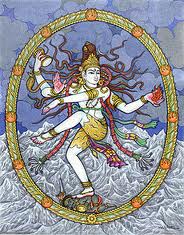
A face with four shoulders, three eyes, to the left destructive fire (in the hand), moon and leaves on the head, hand stretching downwards, the raised foot pointing down, to the right swastika earring, Damarukam (drum), ga.nga (in the head), and protection posture, salutations to that God of ceaseless dance whose matted hair is flowing, standing on the unconscious body (hyapasmAra dEham)
purANa of the deity : naTa rAjar : king of dance (yOga mUrti)
Lord Shiva dances during the creation, protection and destruction of the worlds, though the kind of His dance varies with respect to the action. (san^dhyA tAnDava, Urdhva tANDava, rudra tANDava, samhAra tANDava etc.). The dance of the Lord takes place in every minute particle, for all of us to exist and act. That is the source of all the energy. His movement is shakti. Yogis hear and see the dance of the Lord by invoking the kuNDalinI shakti.
There were two ardent sages vyAgrapAda and patanjali who were worshipping God to see Its blissful dance that energizes the worlds. vyAgrapAda out of his devotion asked for the eyes and legs of the tiger, so that he could go very early in the dawn, even before the bees wake up, to pluck the flowers very fresh - not even touched by the bees to offer to God ! That is why he was called vyAgrapAda. The other sage was the serpent AdiseSha on which mahA viShNu reside, desired to see the glorious Dance of God. They were performing austerity at the holy place called thillai .
At the same time bhadrakAli (1), the fierce form of goddess asked for a competition with God in dance. God and mahAkAli came to the thillai, where the sages were performing austerity to see His dance and there began the competition between kAli and Lord shiva. The Lord, Who keeps dancing creating, protecting, destroying, hiding and blessing, won the play by acting the Urdva tANDava, raising His Feet to His Head. The gracious dance of the God filled the hearts of the sages and those who ardently seek Him.
Lord Shiva danced in the five ambalams during various occasions. Out of them chithambaram is very much renowned. Lord danced here to fulfill the worship of patanjali and vyAghra pAda mahaR^ishis.
purANa of the deity : naTa rAjar : king of dance (yOga mUrti)
Lord Shiva dances during the creation, protection and destruction of the worlds, though the kind of His dance varies with respect to the action. (san^dhyA tAnDava, Urdhva tANDava, rudra tANDava, samhAra tANDava etc.). The dance of the Lord takes place in every minute particle, for all of us to exist and act. That is the source of all the energy. His movement is shakti. Yogis hear and see the dance of the Lord by invoking the kuNDalinI shakti.
There were two ardent sages vyAgrapAda and patanjali who were worshipping God to see Its blissful dance that energizes the worlds. vyAgrapAda out of his devotion asked for the eyes and legs of the tiger, so that he could go very early in the dawn, even before the bees wake up, to pluck the flowers very fresh - not even touched by the bees to offer to God ! That is why he was called vyAgrapAda. The other sage was the serpent AdiseSha on which mahA viShNu reside, desired to see the glorious Dance of God. They were performing austerity at the holy place called thillai .
At the same time bhadrakAli (1), the fierce form of goddess asked for a competition with God in dance. God and mahAkAli came to the thillai, where the sages were performing austerity to see His dance and there began the competition between kAli and Lord shiva. The Lord, Who keeps dancing creating, protecting, destroying, hiding and blessing, won the play by acting the Urdva tANDava, raising His Feet to His Head. The gracious dance of the God filled the hearts of the sages and those who ardently seek Him.
Lord Shiva danced in the five ambalams during various occasions. Out of them chithambaram is very much renowned. Lord danced here to fulfill the worship of patanjali and vyAghra pAda mahaR^ishis.
